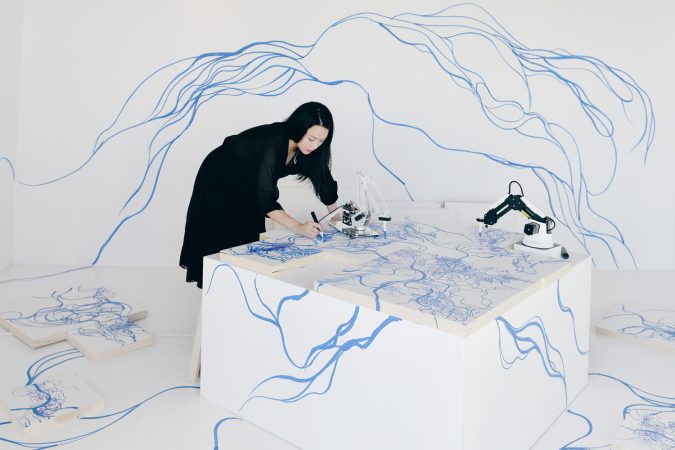Photo credit: Sougwen Chung
AI is rapidly transforming the digital art world, influencing how we create, interact with, and understand art. Once confined to the realm of science fiction, AI technologies such as neural networks, machine learning, and algorithms are now a part of creative processes. These systems are more than just tools—they are collaborators that challenge conventional ideas of authorship and creativity, reshaping the boundaries of what we consider art. However, while AI-driven art has been making waves, the market is not fully convinced yet, with many traditional collectors still hesitant. That said, a shift is undeniable: younger generations, digital natives at heart, are embracing AI’s place in the art world, and this enthusiasm is driving more AI artists to the auction stage.
At the forefront of this movement are artists like Sougwen Chung, Refik Anadol, and Mario Klingemann, who each push the limits of artistic expression through AI. Their work exemplifies how technology is not only revolutionizing the production of art but also its perception. Chung, for example, thrives on human-machine collaboration, using robotic systems that draw alongside her in real-time, blending human touch with the precision of AI. This blurred boundary forces viewers to reconsider the artist’s role in the creative process. In 2019, Chung’s pioneering work earned her the prestigious Lumen Prize, further cementing her place in the AI art scene. Yet, the question remains: when technology plays such a key role, who truly owns the creative output?

Refik Anadol takes a different approach, merging AI and vast amounts of data to create immersive installations. His groundbreaking work Unsupervised, exhibited at the Museum of Modern Art (MoMA), translates massive datasets into dynamic, visual experiences that challenge how we engage with the history of art. His use of AI offers a glimpse into how technology can reimagine narratives, presenting collections through a new, ever-evolving lens.

Similarly, Mario Klingemann, a pioneer in AI art, uses neural networks to generate works that challenge traditional aesthetics. His generative art, created without human intervention, raises questions about the nature of creativity. Is a work of art still considered original when produced by an algorithm? By relinquishing control to AI, Klingemann’s pieces prompt reflection on the evolving relationship between humans and machines in artistic creation.
Beyond individual artists, AI is also influencing how art is curated and exhibited. Hans Ulrich Obrist, the renowned curator at London’s Serpentine Galleries, has explored AI’s potential in curatorial practices. Obrist’s efforts to integrate AI into the curatorial process signal a growing recognition of technology’s impact on contemporary art. His exhibitions highlight the ways in which AI not only influences the creation of art but also how it is presented and understood by the public. The very role of the curator is shifting in response to these new technologies, opening up questions about the future of exhibitions.
A critical question now looms over the entire art world: Will Artificial Intelligence enhance human creativity, or is it on the verge of fundamentally redefining the role of the artist? While some speculate that we may be heading toward a future where machines—not humans—are the primary creators, the market remains divided. However, the next generation of art lovers and collectors is already signaling a shift. Younger collectors, with 44% expressing excitement about AI’s potential, far outpace the more cautious older generation, of whom only 23% share the same enthusiasm. They are captivated by these new possibilities, embracing the dynamic fusion of technology and art with open arms.
As this shift unfolds, one thing is certain—AI is reshaping the art world in ways that were once unimaginable, challenging not only the traditional roles of artists and curators but also what art itself can be. And while some remain cautious, the allure of AI’s potential is undeniable, with a new wave of collectors ready to invest in the future of creativity.
Are you a student or recent graduate eager to contribute your voice to ArtTactic’s Editorial vision? We’d love to hear from you!
Reach out to our Commissioning Editor, Margaret Hong (margaret@arttactic.com) for more information.

